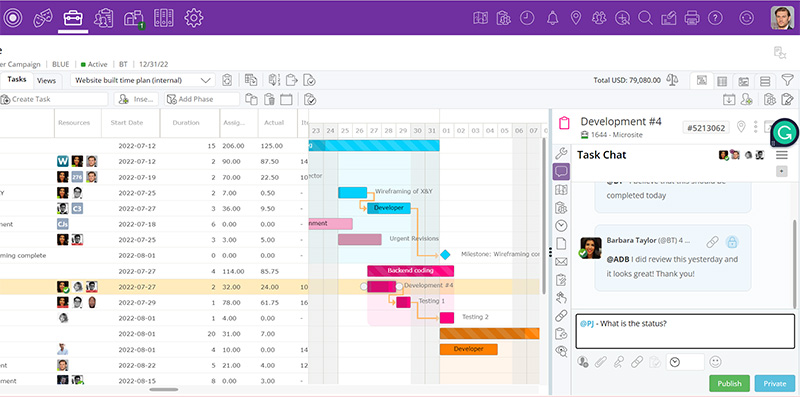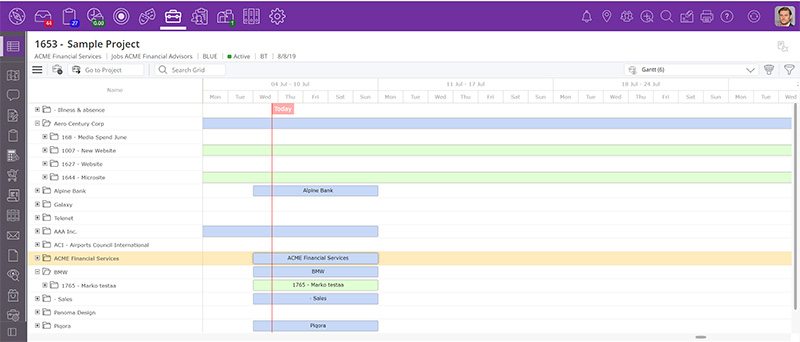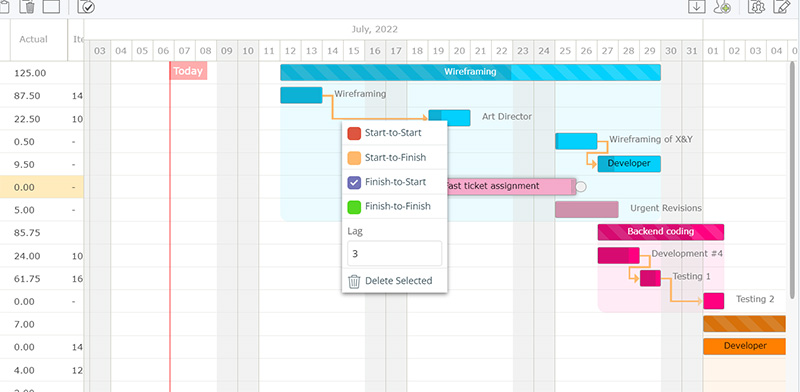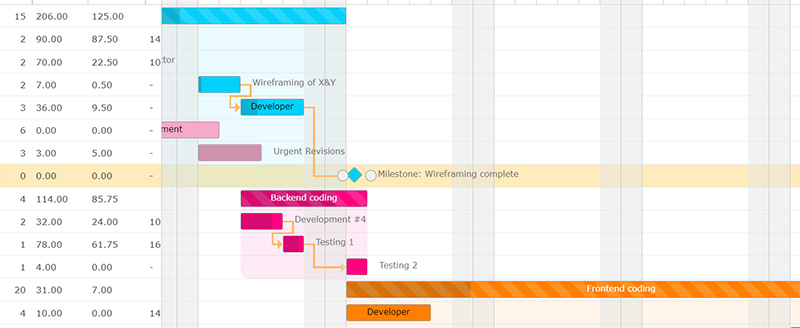
By: Mike Haile, Founder of AgencySoft, a Deltek WorkBook Partner
A Gantt chart is a type of bar chart that shows the start and finish dates of specific tasks or projects and how they relate to one another. It can be used for a variety of purposes, such as project planning, tracking progress, and estimating costs, and is a terrific way to visualize your project timeline and track the progress of your project.
Gantt charts help you to identify potential bottlenecks and delays so that you can take corrective action before it’s too late. They also visually show any task dependencies and relationships. For example, one task is dependent on another, or it can only be started when the preceding task has been completed. The most useful Gantt charts will also show all resources working on each task and their progress.
Gantt charts can be used to visualize any type of project, for example, the construction of a building, the launch of a new product, the development of a website, or an advertising campaign. They are especially useful for projects that involve multiple tasks or milestones that need to be completed in a specific order.
The Basics of Creating a Gantt Chart
The basics of creating a Gantt chart are relatively simple. First, you need to identify all the tasks that need to be completed as part of your project. Next, you need to estimate the amount of time each task will take. Finally, you need to create a bar chart that shows the start and finish dates for each task.
The best way to create and maintain a Gantt chart is using project management software and there are lots of alternatives on the market from Microsoft Project all the way to Jira, but if you want a software that’s easy to use, you need to try Deltek WorkBook.
Gantt Chart example in Deltek WorkBook
Deltek WorkBook is a cloud-based agency management system that manages resources, schedules jobs and keeps track of time. The tool allows organizations to manage projects, control budget, store documents and more.
WorkBook makes it easy to assign resources by dragging and dropping them on each task and allocating the hours that an employee needs to work.
Gantt Chart in Project Management
Once you have created your Gantt chart, you can (and should) use it to track the progress of your project. This is done by tracking the progress of each task and marking it off as complete. As the project progresses, you will be able to see at a glance which tasks are on schedule, and which are behind.
If tasks are overrunning, the chart is used to see what the impact is on the overall project progress. This will give you the opportunity to course-correct or plenty of warning that the project is going to overrun.
10 Tips For Project Planning with Gantt Charts
There are a few things you can do to make the most out of your Gantt chart.
1. Define your project scope and objectives
Before you can create a Gantt chart, you need to have a clear understanding of your project scope and objectives. This will help you to identify the tasks that need to be completed and the dependencies between them.
2. Break down your project into smaller tasks
Once you have defined your project scope and objectives, you need to break down the project into smaller tasks. This will make it easier to create the Gantt chart and track the progress of the project.
3. Identify the dependencies between tasks
To create a Gantt chart, you need to identify the dependencies between tasks. This will help you to determine the order in which the tasks need to be completed and include the dependencies while creating the tasks in your software. If you don’t use project management software, then you have to track the dependencies when/if the plan changes. That may lead to mistakes.
4. Estimate the duration of each task
This will help you to determine the length of the project and its “critical path” – the fastest time that the project can be achieved.
5. Create the Gantt Chart
Once you have all the information required, you can create the Gantt chart although in practice most project Gantt charts are copied from previous projects or templates. Again this is where project management tools help.
6. Update as the project progresses
As the project progresses, you will need to update the Gantt chart. This will help you to track the progress of the project and to identify any potential problems.
7. Use it to communicate with stakeholders
The Gantt chart can be a valuable communication tool for project stakeholders. It can help to keep them informed of the project’s progress and to identify any potential problems.
8. Track project milestones
It’s a tool for tracking project milestones. This will help you to ensure that the project is on track and identify any potential problems.
9. Identify potential risks
Identifying and tracking potential risks will help you to take corrective action before it’s too late.
10. Use it to improve your project management skills.
The Gantt chart can be a valuable tool for improving your project management skills. This will help you to better understand the project management process and to identify any potential problems.
Creating and using a Gantt chart is a great way to keep track of your project’s progress and identify potential problems. However, it is important to use them wisely to avoid common pitfalls. By following the tips in this article, you can make the most out of your Gantt chart and ensure that your project stays on track.
This article is courtesy of our partner, Agency Soft. The original post can be found here.
About Agency Soft
Agency Soft specializes in providing agencies and other professional services businesses with software solutions to improve the profitability of their projects and the efficiency of their resources. We do this by implementing Deltek WorkBook and Deltek ConceptShare solutions in their businesses, so they are able to grow and collaborate without hindrance. Our team of experts has more than 40 years of experience or working with professional services companies.

Deltek Project Nation Newsletter
Subscribe to receive the latest news and best practices across a range of relevant topics and industries.

 Log In
Log In















